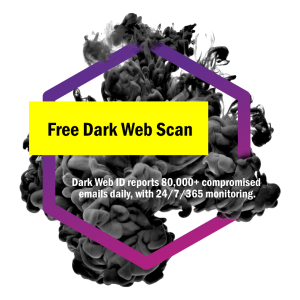Are Your Company’s Digital Credentials For Sale On The Dark Web?
Find Out With A Complimentary Dark Web Scan 
 The “Dark Web” is a part of the World Wide Web that requires special software to access. Once inside, web sites and other services can be accessed. Identity thieves use the Dark Web to buy and sell personal information. If your email address is there, criminals can potentially gain access to accounts associated with it. Scanning your email is a great first step to better protect your identity because it gives you the knowledge you need to act.
The “Dark Web” is a part of the World Wide Web that requires special software to access. Once inside, web sites and other services can be accessed. Identity thieves use the Dark Web to buy and sell personal information. If your email address is there, criminals can potentially gain access to accounts associated with it. Scanning your email is a great first step to better protect your identity because it gives you the knowledge you need to act.
Find Compromised Credentials Used To Exploit Employees And Customers
To help keep your critical business assets safe from the compromises that lead to breach and theft, we are offering a complimentary, one-time scan with Dark Web ID™ Credential Monitoring to see what might already been for sale on the Dark Web.
Our Dark Web ID Credential Monitoring detects compromised credentials in real-time on the Dark Web and notifies you immediately when these critical assets are compromised, before they can be used for identity theft, data breaches, or other crime. Digital credentials such as usernames and passwords connect you and your employees to critical business applications, as well as online services. Unfortunately, criminals know this — and that’s why digital credentials are among the most valuable assets found on the Dark Web.
Companies that have had their credentials compromised and sold on the Dark Web don’t know it until they have been informed by law enforcement — but by then, it’s too late. According to National Institute of Standards and Technology (NIST), small and medium-sized businesses may have more to lose than larger organizations, because cybersecurity events can be costly and threaten their survival.
“Cybersecurity doesn’t have to be too overwhelming, expensive or complicated. The first step to protecting your business is understanding your risk!”

About GeeksHD Dark Web Monitoring
GeeksHD Dark Web Monitoring provides a comprehensive set of threat intelligence and identity monitoring solutions to private and public sector organizations and to millions of individuals impacted by cyber incidents. The company’s flagship product, GeeksHD Dark Web Monitoring, combines human and sophisticated Dark Web intelligence with capabilities to identify, analyze and monitor for compromised or stolen employee and customer data, mitigating exposure to clients’ most valuable assets – their digital identity. From monitoring your organization’s domain for compromised credentials to deploying identity and credit management programs in order to protect the employees and customers you serve –GeeksHD Dark Web Monitoring has the solution.
Frequently Asked Questions
The Dark Web is a hidden universe contained within the “Deep Web”- a sub-layer of the Internet that is hidden from conventional search engines. Search engines like Google, BING and Yahoo only search .04% of the indexed or “surface” Internet. The other 99.96% of the Web consists of databases, private academic and government networks, and the Dark Web. The Dark Web is estimated at 550 times larger than the surface Web and growing. Because you can operate anonymously, the Dark Web holds a wealth of stolen data and illegal activity.
GeeksHD’s service is designed to help both public and private sector organizations detect and mitigate cyber threats that leverage stolen email addresses and passwords. GeeksHD Dark Web Monitoring leverages a combination of human and artificial intelligence that scours botnets, criminal chat rooms, blogs, Websites and bulletin boards, Peer to Peer networks, forums, private networks, and other black-market sites 24/7, 365 days a year to identify stolen credentials and other personally identifiable information (PII).
GeeksHD Dark Web Monitoring focuses on cyber threats that are specific to our clients’ environments. We monitor the Dark Web and the criminal hacker underground for exposure of our clients’ credentials to malicious individuals. We accomplish this by looking specifically for our clients’ top-level email domains. When a credential is identified, we harvest it. While we harvest data from typical hacker sites like Pastebin, a lot of our data originates from sites that require credibility or a membership within the hacker community to enter. To that end, we monitor over 500 distinct Internet relay chatroom (IRC) channels, 600,000 private Websites, 600 twitter feeds, and execute 10,000 refined queries daily.
While we can’t say definitively that the data we’ve discovered has already been used to exploit your organization, the fact that we are able to identify this data should be very concerning. Organizations should consult their internal or external IT and/or security teams to determine if they have suffered a cyber incident or data breach.
Some Of The Data Is Old Or For Employees No Longer Working For Us. Does That Mean We're Not At Risk?
While employees may have moved on from your organization, their company issued credentials can still be active and valid within the 3rd party systems they used while employed. In many cases, the 3rd party systems or databases that have been compromised have been in existence for 10+ years holding millions of “zombie” accounts that can be used to exploit an organization. Discovery of credentials from legacy employees should be a good reminder to confirm you’ve shut down any active internal and 3rd party accounts that could be used for exploit.
It delivers the same advanced credential monitoring capabilities used by Fortune 500 companies. It connects to multiple Dark Web servers including Tor, 12P and Freenet, to search for compromised credentials, without requiring you to connect any of your software or hardware to these high-risk services directly. Proactive solution provides real-time awareness of compromised credentials before identify theft or data breaches occur.
Compromised credentials are used to contact further criminal activity, such as data breaches of sensitive corporate information, as well as identity theft of individual employees. Users often have the same password for multiple services, such as network logon, social media, online stores and other services, exponentially increasing the potential damage from a single compromised username and password.
